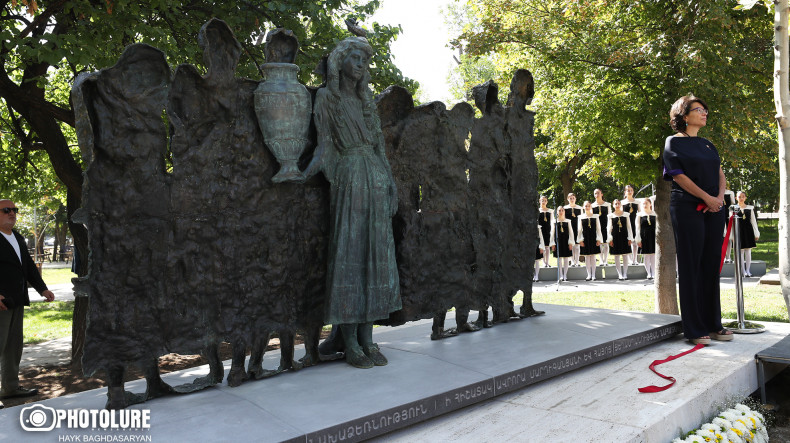
Memorial to Aurora Mardiganian and the Armenian Genocide martyrs unveiled in Yerevan
Today, the Memorial to Aurora Mardiganian and the Martyrs of the Armenian Genocide was unveiled in Yerevan, Armenia, in the park area near the Komitas Museum-Institute. The monument was envisioned and brought to life by the Aurora Humanitarian Initiative. Its unveiling was followed by a special screening of Aurora's Sunrise, an award-winning animated documentary depicting Mardiganian’s remarkable journey.
Aurora Mardiganian was a young girl who escaped the horrors of the Armenian Genocide, moving to America, where she became a silent-era Hollywood star and a philanthropist. Her story inspired Noubar Afeyan, Vartan Gregorian, and Ruben Vardanyan, Co-Founders of the Aurora Humanitarian Initiative, who named the Initiative in her honor. The Memorial also pays tribute to the 1.5 million canonized martyrs who perished during the Armenian Genocide of 1915–1923. Soil from Aurora Mardiganian’s resting place in Los Angeles, California, in the United States, along with a relic from the victims of the Deir ez-Zor desert brought from Antelias, Lebanon, have been placed beneath this monument.
(1).jpg)
“As an Armenian, this monument holds profound significance for me. It embodies our gratitude to Aurora Mardiganian and our joy that she has finally returned home,” said musician and theater critic Marine Ales, whose guidance and vision as Chair of Aurora’s Creative Council helped bring the Memorial to life. “The Memorial is also the symbol of our enduring memory and respect. I feel very strongly that we have a responsibility to the next generation to pass on universal human values, especially today, in a time when the world faces great challenges.”
In this two-sided sculpture, created by Italian-Armenian sculptor Vighen Avetis, each side reflects the life of Aurora Mardiganian—her journey through the atrocities of the Genocide and her salvation in the US. The back of the sculpture depicts women suffering along the paths of the Deir ez-Zor desert, with young Aurora among them. On the front, she stands apart as a woman who overcame death and shared her story with the world, becoming a symbol of courage and survival for generations. The two edges of the sculpture are not aligned—the distance between them allows the two stages of Aurora’s life to connect through light and shadow.
“Designing this sculpture has been a daunting yet deeply inspiring challenge, so I am both humbled and honored to present it today,” stated Vighen Avetis, author of the Memorial. “Dedicated to the remarkable Aurora Mardiganian, this monument is a meaningful addition to Yerevan’s humanitarian landscape, standing as a testament to courage, survival, and enduring hope. I am forever grateful to have been part of this inspiring project.”
The unveiling was attended by Archbishop Khajag Barsamian, Pontifical Legate of Western Europe and Representative of the Catholicos of All Armenians in Vatican; Noubar Afeyan, Co-Founder and Chair of the Board of the Aurora Humanitarian Initiative; Veronika Zonabend, Founding Partner and Chair of the Board of Governors of UWC Dilijan; Anna Afeyan, Eric Esrailian and Arman Jilavian, Board Members of the Aurora Humanitarian Initiative; and representatives from the city of Yerevan and the Ministry of Education, Culture, and Sports, among other notable guests.
During the presentation, Veronika Zonabend and Anna Afeyan unveiled the Memorial, joining Aurora’s call for humanity and gratitude. The event also featured a moving performance by the Little Singers of Armenia Children’s Choir led by Tigran Hekekyan, who captivated the audience with their heartfelt rendition of traditional Armenian songs.
As part of the event, the Chronicles of Aurora, the first manuscript created in the Matenadaran in the 21st century, was made available to the attendees. This special manuscript, dedicated to the history of the Aurora Humanitarian Initiative, was displayed with its final page featuring an illustration of the newly unveiled Memorial. The Chronicles of Aurora will be showcased at the Komitas Museum-Institute until October 7, 2024.





